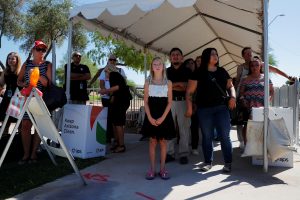
By David Schwartz
PHOENIX (Reuters) – U.S. border agents have seized 254 pounds (115 kg) of fentanyl that was stashed in a truck crossing into Arizona from Mexico, marking the largest single bust of the powerful opioid ever made at an American border checkpoint, officials said on Thursday.
The 26-year-old Mexican driver of a cucumber-toting tractor-trailer was arrested after agents on Saturday at the border station in Nogales discovered the fentanyl in a secret compartment, U.S. Customs and Border Protection officials said.
Fentanyl, a synthetic opioid 100 times stronger than morphine that can kill with a 2-milligram dose, has been blamed for fueling an opioid crisis in the United States. It gained notoriety after an overdose of the painkiller was deemed to have killed pop singer Prince in 2016.
The United States had a record 72,000 deaths from drug overdoses in 2017, with opioids responsible for most of those fatalities. President Donald Trump has declared opioid addiction a public health emergency.
The latest seizure in Nogales is the largest-ever confiscation of fentanyl by the U.S. Customs and Border Protection agency, officials said in a statement.
The fentanyl was worth an estimated $3.5 million, based on valuation criteria of the U.S. Drug Enforcement Administration, Hugo Nunez, a spokesman for U.S. Customs and Border Protection, said in an email.
The drugs were found after the truck was pulled over for a secondary inspection and drug-sniffing canines picked up an odor, Michael Humphries, the Nogales Area Port director, told reporters.
The driver, Juan Antonio Torres-Barraza, was charged in federal court in Tucson with two counts of drug possession with the intent to distribute.
An attorney for Torres-Barraza could not immediately be reached for comment.
Another 395 pounds (180 kg) of methamphetamine, worth about $1.1 million, also was confiscated from the truck, officials said.
“Fentanyl is trafficked into the United States largely from China and Mexico but it is not possible to determine which country is a bigger supplier, the DEA said in a report in October.
The U.S. Department of Justice, in a report last year to the U.S. Congress, has said the drug is primarily shipped to the United States from China through cargo containers or international mail. But Chinese fentanyl is sometimes sent to criminal groups in Mexico or Canada and smuggled across the border, the report said.
Last month, Mexican officials busted a fentanyl lab in Mexico City.
(Editing by Alex Dobuzinskis and Dan Grebler)









